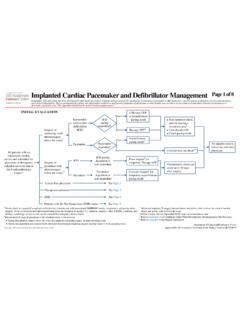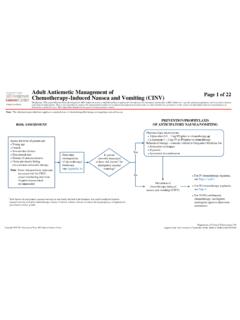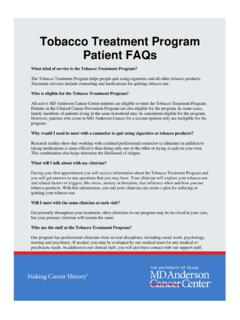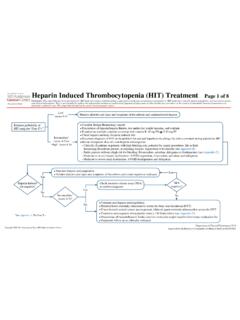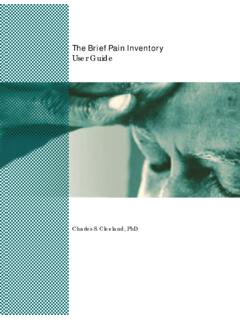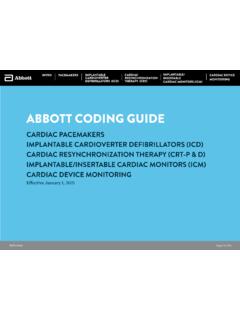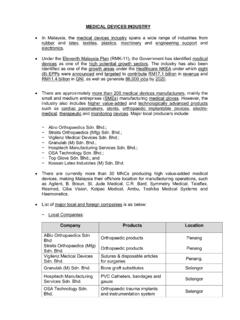Transcription of Peri-Procedure Management of Anticoagulants Page 1 of 29
1 Department of Clinical Effectiveness V5 Approved by the Executive Committee of the Medical Staff on 10/19/2021 Page 1 of 29 Disclaimer: This algorithm has been developed for MD Anderson using a multidisciplinary approach considering circumstances particular to MD Anderson s specific patient population, services and structure, and clinical information. This is not intended to replace the independent medical or professional judgment of physicians or other health care providers in the context of individual clinical circumstances to determine a patient's care. This algorithm should not be used to treat pregnant Management of AnticoagulantsTABLE OF CONTENTSM anagement According to Procedure 2 APPENDIX A: Procedure Bleeding 3-8 APPENDIX B: Reversal of 9-10 APPENDIX C: Management of Anticoagulant for Regional Anesthesia (neuraxial and deep peripheral nerve procedures, including lumbar puncture).
2 Pages 11-12 APPENDIX D: Procedure Bleeding Risk and Management of Anticoagulants for Interventional Spine and Pain 13-15 APPENDIX E: Procedure Bleeding Risk and Management of Anticoagulants for Neurosurgery 16-19 APPENDIX F: Parenteral Anticoagulant 20-22 APPENDIX G: Warfarin 23 APPENDIX H: Direct Oral Anticoagulants (DOACs) 24 APPENDIX I: Thromboembolic 25 APPENDIX J: Child-Pugh Scoring 26 Suggested 27-28 Development 29 Department of Clinical Effectiveness V5 Approved by the Executive Committee of the Medical Staff on 10/19/20211 For patients on antiplatelet therapy, see Peri-Procedure Management of Antiplatelet Therapy algorithm2 For patients with recent ischemic stroke, consult Neurology for further recommendations as indicated3 See Appendix A for Procedural Bleeding Risks based on type of procedure 4 See Appendix I for Thromboembolic Risks5 If patient is on parenteral anticoagulant, see Appendix F; if on warfarin, see Appendix G.
3 If on DOACs, see Appendix H 6 Refer to Transitioning Between Anticoagulants (for internal use only) to assist with transitioning DOAC to a parenteral anticoagulant Page 2 of 29 Disclaimer: This algorithm has been developed for MD Anderson using a multidisciplinary approach considering circumstances particular to MD Anderson s specific patient population, services and structure, and clinical information. This is not intended to replace the independent medical or professional judgment of physicians or other health care providers in the context of individual clinical circumstances to determine a patient's care. This algorithm should not be used to treat pregnant Management of AnticoagulantsPatient on anticoagulantscheduled for procedure1 (The primary care team will determine whether the procedure can be done safely while the patient is on an anticoagulant after discussion with the patient regarding the overall risk of bleeding) If urgent or emergent procedure, consider anticoagulant reversal if indicated (see Appendix B)
4 If possible, delay elective procedures for 1 month after acute VTE or ischemic stroke2 In patients with new onset atrial fibrillation/atrial flutter who have been on anticoagulation for < 1 month, recommend TEE to rule out cardiac thrombus prior to holding anticoagulant therapy See Appendix C for Management of Anticoagulants for regional anesthesia (neuraxial and peripheral nerve procedures including lumbar puncture) See Appendix D to determine bleeding risk and for Management of Anticoagulants based on bleeding risk for interventional spine and pain procedures See Appendix E to determine bleeding risk and for Management of Anticoagulants based on bleeding risk for neurosurgery proceduresLow bleeding risk procedure3?NoYesContinue current anticoagulantUrgent/emergent procedure?
5 Patient with low thromboembolic risk4?NoYes Interrupt anticoagulant5 Do NOT bridge if patient is on warfarin Do NOT bridge if patient is on DOAC Interrupt anticoagulant5 Bridge if patient is on warfarin For moderate risk bleeding procedures, do NOT bridge if patient on DOAC For high risk bleeding procedures, bridge if patient on DOAC6. Consult Benign Hematology for assistance in anesthesia (neuraxial and peripheral nerve procedures including lumbar puncture)orInterventional spine and pain proceduresorNeurosurgery proceduresOther proceduresMANAGEMENT PRE- AND POST-PROCEDUREFor restart recommendations, refer to Management based on anticoagulant: Parenteral agents, see Appendix F Warfarin, see Appendix G DOACs, see Appendix HYesNo Consider anticoagulant reversal if indicated (see Appendix B) In patients with new onset atrial fibrillation/atrial flutter who have been on anticoagulation for < 1 month, consider TEE to rule out cardiac thrombus prior to holding anticoagulant therapyPRESENTATION(Inpatient or Outpatient)
6 If possible, delay elective procedures for 1 month after acute VTE or ischemic stroke2 In patients with new onset atrial fibrillation/atrial flutter who have been on anticoagulation for < 1 month, recommend TEE to rule out cardiac thrombus prior to holding anticoagulant therapyDOACs = direct oral anticoagulantsTEE = transesophageal echocardiogramVTE = venous thromboembolismEVALUATIONAPPENDIX A: Procedure Bleeding RiskPage 3 of 29 Disclaimer: This algorithm has been developed for MD Anderson using a multidisciplinary approach considering circumstances particular to MD Anderson s specific patient population, services and structure, and clinical information. This is not intended to replace the independent medical or professional judgment of physicians or other health care providers in the context of individual clinical circumstances to determine a patient's care.
7 This algorithm should not be used to treat pregnant Management of AnticoagulantsDepartment of Clinical Effectiveness V5 Approved by the Executive Committee of the Medical Staff on 10/19/2021 Note: For patients who have other risk factors for bleeding ( , recent bleeding event, thrombocytopenia) consider utilizing the Management recommendations for high risk bleeding on next pageHigh Bleeding RiskModerate Bleeding RiskLow Bleeding RiskGeneral Procedures Regional anesthesia (neuraxial and deep peripheral nerve procedures) including lumbar puncture (see Appendix C) Bone marrow aspiration and biopsy Venous port placement Ommaya reservoir punctureCardiology Procedures Coronary intervention Endomyocardial biopsy implantable cardioverter- defibrillator /pacemaker lead extraction Left atrial appendage occlusion device Pericardiocentesis Diagnostic coronary angiography via femoral access Electrophysiology testing and/or ablation Pacemaker or defibrillator placement Right heart catheterization Supraventricular tachycardia ablation Transvenous atrial fibrillation ablation Arterioventricular node ablation Coronary artery angiography (radial approach) Internal cardiac defibrillator implantation battery change Permanent pacemaker implantation battery changeDental Procedures1 Alevolar surgery (bone removal)
8 Apicoectomy (root removal) Complex dental procedure/multiple tooth extraction Reconstructive dental procedures Endodontic (root canal) procedures Peridontal surgery, abscess incision Up to 2 tooth extractions Dental hygiene Minor dental procedures1 For moderate risk of bleeding dental procedures in patients on vitamin K antagonists (VKA), either continue VKA in combination with a pro-hemostatic mouthwash or hold VKA 2-3 days prior to procedureDermatologic ProceduresN/AN/A Dermatologic procedures Mohs Center proceduresBreast Surgical and Breast Radiology Procedures All OR Breast Surgical procedures Biopsy and fine needle aspiration of breast, axillary nodal basins, internal mammary, and/or supraclavicular lymph nodes Image guided pre-operative localization of the breast Breast punch biopsy in clinicAPPENDIX A: Procedure Bleeding Risk - continuedPage 4 of 29 Disclaimer: This algorithm has been developed for MD Anderson using a multidisciplinary approach considering circumstances particular to MD Anderson s specific patient population, services and structure, and clinical information.
9 This is not intended to replace the independent medical or professional judgment of physicians or other health care providers in the context of individual clinical circumstances to determine a patient's care. This algorithm should not be used to treat pregnant Management of AnticoagulantsDepartment of Clinical Effectiveness V5 Approved by the Executive Committee of the Medical Staff on 10/19/2021 Continued on next pageHigh Bleeding RiskModerate Bleeding RiskLow Bleeding Risk Gastroenterology Procedures Biliary or pancreatic sphincterotomy and/or dilation Cystogastrostomy Endoscopic hemostasis Endoscopic submucosal dissection (ESD), endoscopic mucosal resection (EMR) or other polypectomy Endoscopic ultrasound with fine needle aspiration Full thickness resection Percutaneous endoscopic gastrostomy (PEG)
10 Placement Pneumatic or bougie dilation Therapeutic balloon-assisted enteroscopy Treatment of varices Tumor ablation by any technique Barrett s esophagus ablation Colonoscopy with biopsy Diagnostic balloon-assisted enteroscopy Endoscopic retrograde cholangiopancreatography (ERCP) with stent and/or biopsy Esophageal or enteral stent Gastroscopy with biopsy Sigmoidoscopy with biopsy Capsule endoscopy Colonoscopy without biopsy Diagnostic esophagogastroduodenoscopy (EGD) Endoscopic retrograde cholangiopancreatography (ERCP) diagnostic Endoscopic ultrasound without fine needle aspiration Push enteroscopy without biopsy Sigmoidoscopy without biopsyGynecology Oncology Procedures All other Gynecology Oncology procedures Cold knife conization (CKC)/loop electrosurgical excision procedure (LEEP) Superficial wide local excisions Colposcopy Dilatation and curettage Endometrial biopsy Exam under anesthesia Hysteroscopy Insertion/Removal of intrauterine device Laser ablation of the cervix/vulva/vagina Vulvar/vaginal/cervical biopsiesNote: For patients who have other risk factors for bleeding ( , recent bleeding event, thrombocytopenia) consider utilizing the Management recommendations for high risk bleeding and Neck Surgery Procedures All other Head and Neck Surgery proceduresN/A Flexible nasopharyngeal laryngoscopy (when performed outside of the OR)APPENDIX A: Procedure Bleeding Risk - continuedPage 5 of 29 Disclaimer.
